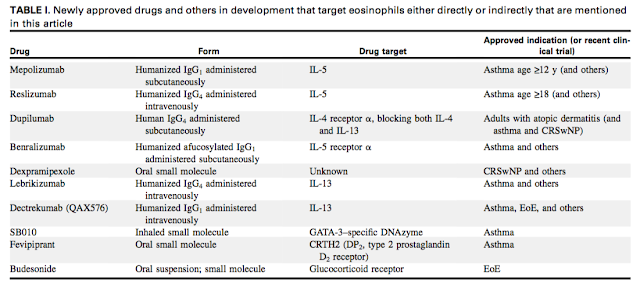Eosinophils and eosinophil-associated diseases: An update
,
②Nat Rev Immunol. 2017 Dec;17(12):746-760.
- 好酸球は、骨髄から発生した、顆粒を含む白血球である
- 顆粒球には、他に好中球、好塩基球、mast cellがある
- 好酸球、好塩基球、mast cellは、転写因子であるGATA1(+)のgranulocyte–monocyte precursor (GMP) から分化する
- GATA1(+):好酸球、mast cells, 巨核球、赤血球系
- GATA1(ー)granulocyte–monocyte precursor (GMP) から分化:好中球、リンパ球、マクロファージ
- Bouffiらは、好酸球の成熟の過程における、globalな転写因子の変化を調べた
- GMPs, eosinophil lineage–committed progenitors (EoPs), 成熟した好酸球をマウスの骨髄から抽出し、RNAシークエンスで調べた
- GMP ~ EoP stages:490 種類の遺伝子が変化していた
- EoP ~ eosinophil stages:1199 種類の遺伝子が変化していた
- 好酸球(GMPではなく)に発現している遺伝子の中で、56種類は転写因子をコードする遺伝子であり、その中に2種類のIkaros family members (Helios, Aiolos)が含まれていた
FIG 1. Recent advances in our understanding of eosinophil development, subset diversity, and function in
peripheral tissues. Bone Marrow, Eosinophils develop from GATA-11 pre-GMPs in the bone marrow. These
pre-GMPs give rise to GMPs that (at least in mice) respond to IL-33 through the ST2 receptor, which pro-
motes eosinophil development and IL-5 receptor a (IL-5Ra) expression. GMPs express higher levels of pro-
cessed XBP1 mRNA, which is essential later in development. These GMPs give rise to Siglec-F1IL-5Ra1
mouse eosinophil precursors (EoPres). Additionally, IL-33 promotes eosinophil development by inducing
IL-5 expression from other bone marrow cells, acting on EoPres and EoPs, which then follow EoPres in line-
age development. EoPs express higher levels of Helios and Aiolos, members of the Ikaros family of tran-
scription factors, which can play a role in regulating gene expression during eosinophil development and
remain highly expressed in mature mouse eosinophils. Proper granule maturation requires expression of
the transcription factor XBP1, inhibition of cysteine protease activity by cystatin F, and crystallization of
the granule protein MBP-1 in a nontoxic form. Improper granule maturation can lead to loss of cell viability
and blockade of eosinophil development. The long noncoding RNA Morrbid is highly expressed in eosinophils and other short-lived myeloid cells and has been found to prevent cell death by inhibiting tran-
scription of the proapoptotic Bcl2 family member Bim. Activated eosinophil, In the periphery eosinophil
activation leads to granule acidification, thereby priming MBP-1 by altering its conformation. On release,
MBP-1 exerts a toxic effect on pathogens and host tissues through aggregation. Lung, Distinct eosinophil
subsets exist in the mouse lung distinguishable by surface marker expression: lung rEos that traffic to
the lung under steady-state conditions and recruited iEos, which can be further subdivided by Gr-1 expres-
sion that corresponds to distinct sets of chemokine and cytokine products. rEos appear to possess regula-
tory properties, such as inhibiting maturation of type 2–biased allergen-loaded dendritic cells, that iEos do
not. Sialosides on the mucins Muc4 and Muc5b bind to Siglec-F to induce eosinophil apoptosis in the
mouse airway. ILC2s in the lung, in response to IL-33 signaling caused by Alternaria species exposure, pro-
duce IL-5 that promotes eosinophilopoiesis. Adipose Tissue, IL-5–activated mouse eosinophils indirectly
promote energy expenditure in beige adipocytes by inducing release of epinephrine and norepinephrine
from AAMs through IL-4 secretion. ILC2s produce IL-5 but also act directly and independently on beige ad-
ipocytes through release of enkephalin peptides. Both directly and indirectly, eosinophils cause blood
vessel relaxation in PVAT through adiponectin and catecholamine release, respectively. The catechol-
amines signal through b3-adrenergic receptors (b3-AR) on adipocytes to cause vessel relaxation through ni-
tric oxide (NO) and adiponectin. Illustration were provided by Jacqueline Schaffer.
顆粒
- 顆粒の内容も、細胞によって異なり、ヒトの好酸球は以下の4種類のcationic proteinを豊富に含んでいる
- major basic protein 1 (MBP1; also known as MBP and PRG2)
- eosinophil cationic protein (ECP; also known as RNase3)
- eosinophil-derived neurotoxin (EDN; also known as RNase2)
- eosinophil peroxidase (EPX; also known as EPO)
- X-box binding protein 1 (XBP1)
- 転写因子であり、造血幹細胞のXbp1欠損マウスから、好酸球の成熟に必要であることがわかった
- Xbp1欠損マウスでは、GMPs分画には影響しないが、EoPや成熟好酸球が減少する
- これは、顆粒であるMBPとEPXの転写後成熟が欠損し、顆粒の形成が不完全となり、GATA-1の下流シグナルに影響するためと考えられている
- 分泌細胞(plasma cells, Paneth cells, pancreatic acinar cells)とも関連がある
- stress-response factorsをコードする遺伝子の転写を促進してunfolded protein responseの制御をしている
- cystatin F(leuxocystatinとも呼ばれる)
- 内因性のシステインプロテアーゼ阻害因子
- 顆粒の成熟と好酸球の生存に必須である
好酸球に関連するサイトカイン、ケモカイン
- 好酸球の増加は、Th2細胞を介したサイトカインが関係している
- IL-5:好酸球産生を促進し、好酸球を活性化する
- IL-5を産生する細胞は、Th2細胞以外に、DCs, ILC2sが想定されている
- IL-5よりは特異性が弱いが、IL-3, GM-CSMも好酸球のpriming、活性化、生存を促進する
- IL-33
- IL-1 family cytokine
- ST2受容体(=IL-33の受容体であり、様々なtype2 immunity cellsに発現している)を介して、好酸球の増加・活性化へ作用する
- pre-GMPがGMPへ分化し、IL-33にST2受容体を介して反応し、それによってIL-5受容体を発現するようになって成熟が促進される
- Andersonらは、naive BALB/c マウスが真菌のaeroallergen(Alternaria alternata)に曝露した場合に、好酸球を肺にリクルートさせてくるのみではなく、骨髄における好酸球の産生を増加させることを報告した
- この現象は、末梢血IL-5を中和させるか、ST2を欠損させるか、ILC2を欠損させたマウスでは生じなかった
- すなわち、真菌抗原への曝露によってIL-33にST2を介してILC2が反応し、IL-5を産生したことが示唆される
- eotaxin 1(CCL11), eotaxin 2(CCL24), eotaxin 3(CCL26) は、人において、組織局所への好酸球の誘導に関与
- IL-4, IL-13により誘導され、IFNγによって抑制される
- 好酸球は宿主の防御に関わると考えられてきたが、そうでないことを示唆するデータもある
- 寄生虫感染症のモデルマウスでは、好酸球増多に保護的な役割がない
- 多細胞生物の寄生虫にとっては、むしろ好酸球から産生されるサイトカイン(IL-10, IL-4)が宿主の免疫を抑制する
好酸球の長期生存を制御する因子
- long noncoding RNA Morrbid が、成熟した好酸球やshort-lived myeloid cellsに高く発現している
- これを欠損したマウスでは、これらの細胞がcell-intrinsic mannerにてアポトーシスを生じる
- HESを有するヒト・マウスから抽出した好酸球生存に関係するサイトカインを加えると、好酸球のMorrbid 発現レベルは増加する。また、これらのサイトカインは、NF-κBシグナルの阻害を防ぐことでBcl-xLのup-regulationを誘導して好酸球の生存を促進する
- 内因性のinhibitor NF-κB inhibitor α(IκBα)を好酸球のみ欠損させると、NF-κBの活性化とBcl-xLの発現が増加し、好酸球の生存が促進する
- これらの研究結果から、Bcl-xLは好酸球の生存に必要十分であり、生存促進サイトカインはいくつかの経路を介して生存・アポトーシスに関係するBcl2 family membersのバランスを調節している
- sialic acid–binding immunoglobulin-like lectin F (Siglec F)は、マウスにおいて、cell-intrinsic mannerにて好酸球の生存促進を制御している
- Kiwamonoらは、マウスにて、2種類のglycoproteins(Muc4, Muc5b)を、Siglec Fのリガンドとして報告している
- マウスの気道上皮細胞から抽出したMucinsは、Siglec Fに結合して、好酸球を細胞死へと誘導する
- Muc5b欠損マウスでは、気道の好酸球性炎症が増悪する
- 他のLectinであるgalectin-1 もまた、好酸球をアポトーシスに誘導することで炎症を抑制する
- galectin-1は、細胞表面のLacNAc residues in O- or N-linked glycansに結合する
- 低濃度では、好酸球がVCAM1を介して血管へ接着するのを促進し、eotaxin-1 への遊走を阻害する
- しかしながら高濃度では、好酸球をアポトーシスに誘導する
- prostaglandin D2 receptor
- Th2リンパ球に発現しているケモカイン受容体(CRTH2)である
- 好酸球を含む、type 2 immune cellsのマーカーとして使用される
- Huangらは、CRTH2を標的にした治療によって、type 2 immunityを抑制した
好酸球から産生されるメディエーターとその役割
- 好酸球の顆粒
- 好酸球の発生、分化、生存に関与:EPX, MBP1, XBP1
- 各種サイトカインも前段階の形態で顆粒内に存在している:Figure1の通り
好酸球の同定
- 組織局所に存在する好酸球は、すぐに細胞もしくは脱顆粒してしまうので、組織学的評価では同定するのが難しい
- MBP1など、好酸球から産生される蛋白や顆粒の存在は、そこに好酸球がいたことを示し、それらに対するモノクローナル抗体で免疫染色をすると感度が上がる
- フローサイトメトリーを使用すると、どの組織にどの程度好酸球がいるかわかる
- これによって、正常の状態でも、様々な臓器にある程度好酸球が常在することがわかった
- 使用する表面マーカーは下のtable1
脱顆粒の仕組み
- 3種類ある
- classical exocytosis
- mast cellや好塩基球がIgE受容体であるFcεRI にリガンドが結合するのと異なり、in vivoでは好酸球が急速に脱顆粒する機序は認められないが、多細胞寄生虫の表面で脱顆粒するのは観察されている
- 二次的に他の機序の2つが生じる
- cytolysis with granule release
- cell-free granuleが放出され、これらには様々な受容体が含まれており、それにリガンドが結合するとシグナルが伝達される
- piecemeal degranulation (PMD)










0 件のコメント:
コメントを投稿